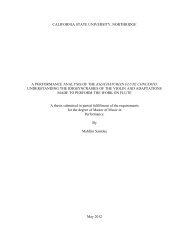Page 1 The California ""- Geographer Annual Publication of the ...
Page 1 The California ""- Geographer Annual Publication of the ...
Page 1 The California ""- Geographer Annual Publication of the ...
Create successful ePaper yourself
Turn your PDF publications into a flip-book with our unique Google optimized e-Paper software.
THE l\IIEXICALI VALLEY \VATER PROBLEM<br />
. JOl-IN c. ARCHBOLD<br />
San Diego City Schools<br />
<strong>The</strong> Mexicali Valley <strong>of</strong> Baja <strong>California</strong> has become a prime producer<br />
<strong>of</strong> cotton and one <strong>of</strong> <strong>the</strong> world's great processors <strong>of</strong> raw cotton. General<br />
argiculture has flourished, too. Like a phoenix arisen from <strong>the</strong> desert this<br />
region has been reclaimed from <strong>the</strong> arid conditions that have gripped<br />
<strong>the</strong> entire area since before <strong>the</strong> white man arrived. Now, salinity left<br />
in <strong>the</strong> soil by draining irrigation waters threatens to wipe out <strong>the</strong> progress<br />
<strong>of</strong> half a century. Only salt-tolerant cotton may survive conditions which<br />
have become an international issue.<br />
North <strong>of</strong> <strong>the</strong> border in <strong>the</strong> summer <strong>of</strong> 1961 <strong>the</strong> U.S. Bureau <strong>of</strong><br />
Reclamation completed <strong>the</strong> vVellton-Mohawk Irrigation and Drainage<br />
District project. <strong>The</strong> $14,000,000 drainage system includes 70 deep drainage<br />
wells with pumps, and a 50-mile concrete-lined conveyance channel<br />
with an outfall on <strong>the</strong> Gila River above Yuma, Arizona (Figure 1).<br />
Drainage water being pumped in <strong>the</strong> Wellton-Mohawk system is<br />
not return Bow in <strong>the</strong> usual sense <strong>of</strong> <strong>the</strong> word, but water accumulated over<br />
a long period <strong>of</strong> tirrie as a result <strong>of</strong> interior drainage. From before <strong>the</strong><br />
turn <strong>of</strong> <strong>the</strong> century until 1952, Wellton-Mohawk farmers depended upon<br />
underground flow <strong>of</strong> <strong>the</strong> Gila River for irrigation water.1 <strong>The</strong> quality <strong>of</strong> this<br />
water was uniformly so poor that it was disclosed in testimony before <strong>the</strong><br />
United States Senate in 1945 that <strong>the</strong> irrigated area was down to 8,000<br />
acres (as <strong>of</strong> 1943; later, even less was in crops) and that samples were<br />
taken showing a salt content <strong>of</strong> 12,000 parts per million.2<br />
In 1952, Colorado River water became available with <strong>the</strong> completion<br />
<strong>of</strong> <strong>the</strong> Gila Project. As substantial amounts <strong>of</strong> water were used to leach<br />
accumulated salts, 50,000 acres were soon in crops and much <strong>of</strong> <strong>the</strong> land<br />
quickly became waterlogged. <strong>The</strong> drainage project was designed to alleviate<br />
this problem.<br />
Pumping this water and conveying it to <strong>the</strong> Gila created many problems.<br />
<strong>The</strong> city <strong>of</strong> Yuma reacted almost immediately, abandoning its<br />
source <strong>of</strong> municipal water from <strong>the</strong> Colorado below its confluence with<br />
<strong>the</strong> Gila, and making arrangements to obtain water upstream. <strong>The</strong> areas<br />
under discussion are included in Figure 4. <strong>The</strong> farmers <strong>of</strong> <strong>the</strong> Mexicali<br />
Valley were hit by high salt loads almost immediately <strong>the</strong>reafter, with<br />
·<br />
disastrous losses resulting.<br />
MEXICALI F ARl\fERS PROTEST.<br />
What were <strong>the</strong> complaints <strong>of</strong> <strong>the</strong> Mexicali farmers? Newspaper ancT<br />
o<strong>the</strong>r accounts first reported protests about water diverted at Morelos Dam<br />
which was used to irrigate grains in <strong>the</strong> fall <strong>of</strong> 1961. Water had not been<br />
ordered in advance for use on <strong>the</strong>se crops, which had germinated early due<br />
to rains. Water tal













